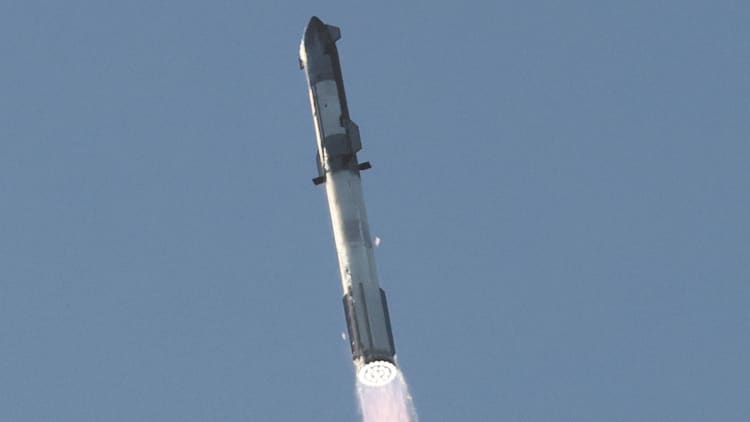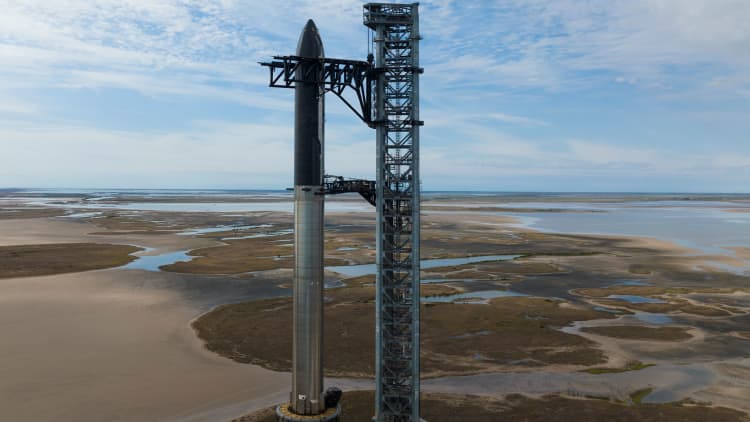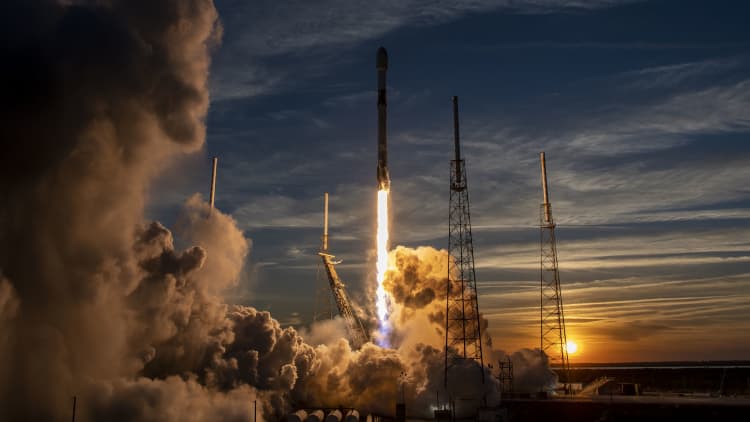
SpaceX launched its second Starship rocket flight on Saturday, with Elon Musk’s company pushing development of the mammoth vehicle past new milestones.
Lifting off around 8 a.m. ET from the company’s facility in Texas, Starship flew for more than seven minutes, successfully separating from its booster before the rocket’s onboard system intentionally destroyed the vehicle mid-flight.
No people were on board the test flight.
“We have lost the data from the second stage … what we do believe right now is that the Automated Flight Termination System on the second stage appears to have triggered very late in the burn,” John Insprucker, SpaceX principal integration engineer, said on the company’s webcast.
SpaceX’s next-generation Starship spacecraft atop its powerful Super Heavy rocket lifts off from the company’s Boca Chica launchpad on an uncrewed test flight, near Brownsville, Texas, U.S. November 18, 2023.
Joe Skipper | Reuters
The flight termination system is a standard safety feature in rockets, as it destroys the vehicle if a problem arises or it flies off course. On SpaceX’s webcast, Starship appears to have been detonated at an altitude of about 148 kilometers (or about 485,000 feet). That is a little under half the altitude at which the International Space Station orbits the Earth.
The intentional destruction of Starship represents a premature end to the flight test, as SpaceX planned to fly it most of the way around the Earth before re-entering the atmosphere and splashing down off the coast of Kauai, Hawaii.
“An incredibly successful day, even though we did have a ‘rapid unscheduled disassembly’ both of the Super Heavy booster and the ship,” SpaceX quality engineering manager Kate Tice said on the webcast.
The Federal Aviation Administration confirmed it will oversee a “mishap” investigation into the flight, a standard regulatory procedure, before SpaceX can launch another Starship rocket.
Mishap investigations are how the FAA analyzes the cause of a rocket launch failure, especially when a vehicle is destroyed. The regulator may give SpaceX corrective actions to complete before the company can receive a license for future Starship launches. The FAA said in a statement after the launch that “no injuries or public property damage have been reported.”
NASA Administrator Bill Nelson congratulated the company for making “progress on today’s flight test.”
“Spaceflight is a bold adventure demanding a can-do spirit and daring innovation. Today’s test is an opportunity to learn—then fly again,” Nelson said in a social media post.
The FAA cleared SpaceX for the second launch earlier this week.
SpaceX first launched a full Starship rocket system in April. Although that flight did not reach space, it successfully achieved multiple historic firsts for an experimental rocket of unprecedented scale. The mid-air destruction of the rocket, as well as an investigation into damage caused back on the ground, triggered a regulatory review that spanned nearly seven months.
The launch attempt comes on the heels of renewed backlash against SpaceX CEO Elon Musk over comments he made online. The White House on Friday condemned what it called “abhorrent promotion of Antisemitic and racist hate” by Musk on his social media platform, X.
Starship system
Starship is both the tallest and most powerful rocket ever launched. Fully stacked on the Super Heavy booster, Starship stands 397 feet tall and is about 30 feet in diameter.
The Super Heavy booster, which stands 232 feet tall, is what begins the rocket’s journey to space. At its base are 33 Raptor engines, which together produce 16.7 million pounds of thrust – about double the 8.8 million pounds of thrust of NASA’s Space Launch System (SLS) rocket, which launched for the first time late last year.
Starship itself, at 165 feet tall, has six Raptor engines – three for use while in the Earth’s atmosphere and three for operating in the vacuum of space.

The rocket is powered by liquid oxygen and liquid methane. The full system requires more than 10 million pounds of propellant for launch.
The Starship system is designed to be fully reusable and aims to become a new method of flying cargo and people beyond Earth. The rocket is also critical to NASA’s plan to return astronauts to the moon. SpaceX won a multibillion-dollar contract from the agency to use Starship as a crewed lunar lander as part of NASA’s Artemis moon program.
Musk previously said he expects the company to spend about $2 billion Starship development this year.
Goals for second flight
There were no people on board this attempt to reach space with Starship. The company’s leadership has previously emphasized that SpaceX expects to fly hundreds of Starship missions before the rocket launches with any crew.
SpaceX was looking to surpass the nearly 4-minute flight of the first launch, reach space with Saturday’s attempt and demonstrate that improvements to its ground infrastructure mitigate the damage caused by the debut attempt.
During the April launch, SpaceX lit only 30 of the 33 Raptor engines at the base of the Super Heavy booster. Other engines were lost mid-flight. Additionally, a communications problem led to an unexpected delay in triggering the rocket’s Autonomous Flight Termination System, which destroys the vehicle in the event it flies off course.
SpaceX introduced upgrades to the launch pad infrastructure as well as the design of the rocket itself for the second attempt.
